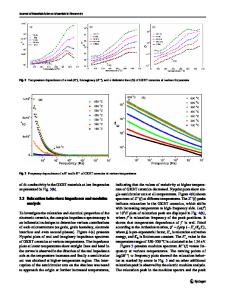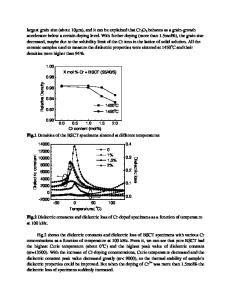Microwave dielectric properties of BaWO 4 -doped Ba(Mg 1/3 Nb 2/3 )O 3 ceramics
- PDF / 1,074,594 Bytes
- 8 Pages / 595.276 x 790.866 pts Page_size
- 57 Downloads / 446 Views
Microwave dielectric properties of BaWO4-doped Ba(Mg1/3Nb2/3)O3 ceramics Sen Peng1,2,*
and Jianming Xu1
1
Provincial Key Laboratory of Informational Service for Rural Area of Southwestern Hunan, Shaoyang University, Shaoyang 422000, China 2 College of Electrical and Information Engineering, Hunan University, Changsha 410082, China
Received: 20 August 2020
ABSTRACT
Accepted: 19 October 2020
In this paper, Ba(Mg1/3Nb2/3)O3 (BMN) ceramics with x (x = 0–9) wt% BaWO4 were synthesized using the conventional solid-state sintering technique. Effects of BaWO4 addition on the microstructure and microwave dielectric properties of BMN ceramics were evaluated. X-ray diffraction (XRD) analysis showed that there were three phases: main crystalline phase Ba(Mg1/3Nb2/3)O3 and secondary phases BaWO4 and Ba5Nb4O15. Meanwhile, the (100) super-lattice reflection peaks shifted to a higher 2h angle with increasing BaWO4 content. SEM photographs suggested that BaWO4 working as a sintering additive promoted the densification and grain growth. The dielectric properties were examined by Vector network analyzer. The dielectric constant (er) was largely determined by the relative density and phase composition. Meanwhile, the addition of BaWO4 had a positive effect on the Q 9 f value, for example the specimen with x = 5 possessed the highest Q 9 f value of 111,300 GHz. Optimum microwave dielectric properties (er = 31.7, Q 9 f = 111,300 GHz (f = 8 GHz) and sf = 0.16 ppm/°C) were obtained for the specimen with x = 5 sintered at 1350 °C for 6 h.
Ó
Springer Science+Business
Media, LLC, part of Springer Nature 2020
1 Introduction With the rapid growth of electronic industry, microwave dielectric ceramics have been used as microwave devices such as microwave filters, path antennas and resonators, which have been extensively used in microwave circuits. Therefore, developing an excellent ceramic material has great application value. How to develop a ceramic with applicable dielectric constant, high quality factor and
Address correspondence to E-mail: [email protected]
https://doi.org/10.1007/s10854-020-04720-w
high temperature stability has been becoming a hot research topic in recent years [1–4]. 0 00 0 Ceramics with general formula Ba(B 1/3B 2/3)O3 (B 00 = Mg and Zn, B = Nb and Ta), which show unique microwave dielectric properties: high dielectric constant, high quality factor (Q 9 f) and near zero temperature coefficient of resonant frequency, are widely used as microwave devices for microwave and millimeter wave technologies [5, 6]. Among these materials, Ba(Mg1/3Nb2/3)O3 is shown to have the
J Mater Sci: Mater Electron
perovskite structure together with superior microwave properties of the permittivity er = 32, quality factor plus resonant frequency Q 9 f = 56,000 GHz, and temperature coefficient of resonant frequency value sf = 33 ppm/°C [7]. However, the sintering conditions required to achieve high performance for BMN ceramics are very stringent [7]. The densification sintering temperature of BMN ceramics reach to 1550 °C [
Data Loading...











